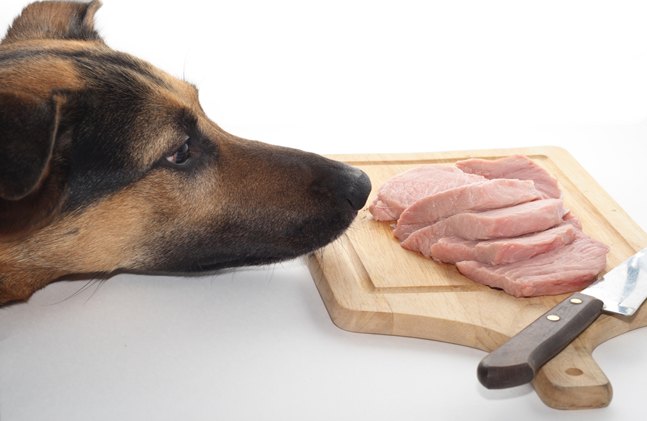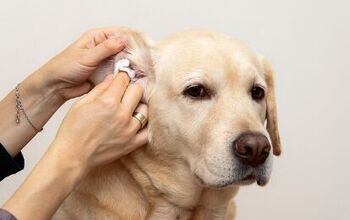Is The BARF Diet Really as Gross As It Sounds?

From a marketing standpoint, calling a diet the “BARF Diet” doesn’t sound too appealing. But for some, it’s the only diet they’ll feed their dogs. Let’s take a closer look at what the BARF Diet is and if something you’d feed your dog.
Before we go on, we’d just like to note that every dog is different. And that means their nutritional needs are different. A certain diet or food that works for a particular dog may not be the right fit for your pooch. It’s important to investigate the different foods and diets out there to ensure your dog is having his nutritional and digestive needs met properly. This will take time and some sleuthing on your part. Digestive health will affect your dog’s overall well-being, so researching different diets is a vital element of being a good pet parent.
Related: Making The Switch To A Raw Food Diet For Dogs?
A type of raw food diet, the BARF Diet is an acronym for Biologically Appropriate Raw Food or Bones And Raw Food. This diet was created by raw food proponent Dr. Ian Billinghurst. He claims that raw food is a dog’s natural diet as they evolved over millions of years, and is still their ideal food source. Processed foods, he believes, are “not what [the] dog was programmed to eat during its long process of evolution.” This raw diet is favored by experts and veterinarians who practice homeopathy or prefer holistic treatments.
The most common BARF Diet is made up of about 80 percent muscle meat with fat, 10 percent organs and 10 percent raw meaty bones (these are soft enough for the dog to chew). As well, giving your dog raw meaty bones as treats throughout the week is also encouraged. Because the BARF Diet is a Raw Diet, it can be varied; you can add other proteins, such as green tripe or a whole egg to the mix. Other raw enthusiasts add fruits and vegetables into the diet. Depending on what your dog’s nutritional needs are, the percentages can be adjusted.
When it comes to serving sizes, Billinghurst recommends doling out an amount of between two to three percent of a dog’s body weight (that translates to.5 lbs. of food per 25 lbs. of body weight). If you’re starting your puppy on a raw diet, they should be getting no more than 10 percent of their body weight or two to three percent of their ideal adult body weight.
Related: 7 Ways To Improve Your Pooch’s Dog Kibble
There are many supporters and detractors of raw food, and they tout their own list of pros and cons.
Here’s what pro-BARFers say about the benefits of this diet:
- Dogs have cleaner teeth and healthier gums
- This diet promotes shinier coats and healthier skin
- There’s no unpleasant bad breath
- It gives dogs lots of energy
- The BARF Diet means less fat and more muscle on your dog
- You’ll notice that you dog has brighter eyes
- The scoop on poop – it’ll be smaller, firmer, and less smelly
- Because the diet makes your dog healthier, it means less health issues and vet bills
- Great for dogs that suffer from allergies
- No chemicals, preservatives, sweeteners, fillers and additives
- No fatty grains
And here’s what the anti-BARFers have to say about the diet:
- The benefits aren’t proven, only anecdotal
- Raw meat can contain harmful bacteria such as E. coli and salmonella
- Uncooked bones can cause airway obstruction, choking, bowel obstruction and intestinal perforations when swallowed
- It can cause inflammation of the gastrointestinal tract and severe diarrhea
- It takes a lot of time to cook the food, find the right mix for your dog and you have to monitor your dog as he eats the food so he doesn’t choke on the bones
- More expensive than traditional kibble
- Nutritional and dietary balance can be a concern
If you’re interested in learning more about raw feeding and the BARF Diet, there are more than a few books out there that can make the transition smoother. Dr. Ian Billinghurst’s “ Give Your Dog A Bone” and “ Grow Your Pup With Bones” are good places to start. Remember, knowledge is key when it comes to properly feeding your dog. If you don’t have the time to prepare it yourself, there are several dog food companies that sell pre-packaged raw meals. Just a few include BARF World, Life’s Abundance and Stella & Chewy’s. There are many out there – all you have to do is Google raw food or BARF Diet food for dogs and you’ll have a mountain to browse through. And because this type of diet is becoming more popular, it seems like we’re hearing about new raw food companies every day!
Do you feed your dog the BARF or raw diet? We’d love to hear your experiences with it and why you chose to go that route. And if you tried this type of diet and it didn’t work for your dog, we want to hear about it too. Please leave your thoughts in the comment section below.

Amy Tokic, Editor of PetGuide.com, is a passionate animal lover and proud pet parent of Oscar, a Shih Tzu/Chihuahua cross, and Zed, a Japanese Chin. Her love of animals began in kindergarten, when she brought her stuffed dog Snoopy into class with her every day. Now, she writes about her adventures in pet ownership and tirelessly researches products, news and health related issues she can share with other animal enthusiasts. In her free time, Amy loves perusing used book and record stores, obsessing over the latest pet products available and chasing squirrels with wild abandon (a habit attributed to spending too much time with her pooches).
More by Amy Tokic























